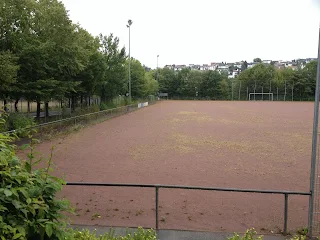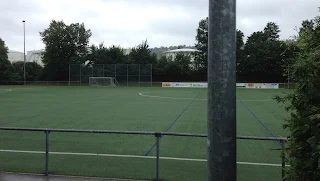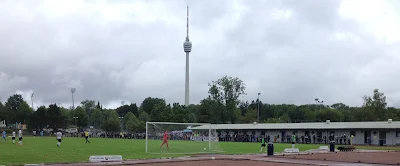Freiburger
FC is a football club from the city of Freiburg im Breisgau in southern
Germany, who were one of the founding clubs in the DFB (German FA) in 1900
after being formed in 1897.
By 1898-99
Freiburger were already Süddeutsche Meisterschaft; Southern German Champions
after hammering 1. FC Pforzheim 6-1 in the final. The popularity of the club
grew allowing the team to play at the military Exerzierplatz to accommodate
crowds.
A second
South German title followed in 1906-07 when 1. FC Nürnberg were defeated 4-2
which allowed the team to compete in the national championships. VfB Leipzig were
beaten before Viktoria 89 Berlin were overcome 3-1 in front of 3,000 fans at
the Stadion am Kanal in Frankenthal to be crowned as champions of Germany.
The club
also went on to play in The Torneo Internazionale Stampa Sportiva the following
season. This was one of the first ever international football clubs. It also
featured Piemonte F.C, Juventus, FC Servette, Torino, FC Ausonia Milano and US
Parisienne.
These
achievements were to be the highest point in the clubs history, even though
they were the dominant club in the city for a couple more decades. In 1915-16 the
Kreisliga Südwest title was won, but the season was localised and affected by the
outbreak of war. Another championship was collected in 1919-20.
The club
moved into the newly built Möslestadion in 1922 prior to joining Bezirksliga
Baden, whose title was won in 1929-30. Freiburger were moved to the Gauliga
Baden, one of sixteen top grade leagues introduced by the Third Reich in 1933. The
team’s best performance was third place in 1933-34, 1938-39 and 1943-44.
Following the
end of World War Two the cub had to be reformed as Fortuna Freiburg becoming
members of 2. Oberliga Süd; which was one of the second tier divisions in the
newly formed state of West Germany.
A couple of
relegations occurred but the team fought back as the club was renamed Freiburg
FC in November 1949. The wooden stand at Möslestadion burned down as the club
lost many artefacts including their title winning pennant of 1907.
FFC were
champions in 1955-56 in the season that they attracted the attendance record on
the 9th December, when the match between the Freiburger FC and 1. FC Nürnberg
attracted 25,000 spectators as Bayern München had to be satisfied with a
runners-up place.
The
promotion proved a step too far as the team was relegated after just one
season. FFC finished third in the renamed II. Division Süd in 1958-59 before
fifth place in 1962-63 was enough to win a place in the second tier Regionalliga
Süd after the introduction of the Bundesliga under coach Hans Wendlandt.
SC Freiburg,
who would go on to become the major club in the city, were still playing at the
Amateurliga Südbaden level. FFC generally occupied a mid table place at the
seasons end with a sixth place in 1969-70 and 1971-72 about the best outcome.
After a
close shave the previous season the team was relegated in 1973-74 to 1. Amateurliga
Südbaden where they came up against SC Freiburg. Third place was achieved in
1975-76 with Wolf-Dieter Siebert coaching the side.
Georg
Gawliczek was coach as Freiburg FC won the Amateurliga Südbaden title to go up
to 2. Bundesliga Süd. Several coaches took turns in charge of the team: Norbert
Wagner, Milovan Beljin, Anton Rudinsky and Bernd Hoss.
2.
Bundesliga was streamlined to one division in 1981-82 as FFC’s run ended following the
earlier death of chairman Rolf Jankovsky and consequent cutting of the playing
budget after the club was only given its license under strict conditions.
Back in
Oberliga Baden-Württemberg fans rallied round to save the club from bankruptcy.
Local rivals SC Freiburg were heading in the opposite direction in 2.
Bundesliga and drawing in new support. A league title cheered the FFC faithful
at Möslestadion in 1983-84 under coach Lutz Hangartner.
The team
missed out on going up in the promotion round and then finished as league
runners-up in 1985-86 after Ulrich Bruder had taken over as coach. The same position
was achieved in 1987-88 before the club underwent a large turnover of coach’s as
the team was relegated to Verbandsliga Südbaden in 1989-90.
Promotion
back to the fifth tier Oberliga Baden-Württemberg came in 1990-91 with
Freiburger’s comeback season ending in fourth place after the appointment of
coach Uwe Ehret. However, the team went back down in bottom place at the
conclusion of the 1993-94 campaign as more coach’s came and went.
The timing
couldn’t be worse as a reorganisation of German league football took place
meaning that FFC were demoted to what was now the seventh level Bezirksliga
Südbaden. Ehret returned to oversee promotion to Landesliga Südbaden in 1998-99.
Another
promotion to the Verbandsliga came in 1999-00 before SC Freiburg made the cash
strapped club an offer that they couldn’t afford for Möslestadion. FFC moved
across the city to take up residence at Schönberg Stadion
as tenants to Blau-Weiß Wiehre.
Former SC
Freiburg player Maximilian Heidenreich took over as coach in January 2001. He
stabilised the playing side of the club as the team finished fourth in 2007-08.
Despite this and being the longest ever serving coach at the club he was fired
in April 2008.
Once again
Freburger found themselves in financial trouble, this time through rental
charges at Schönberg Stadion. The club had long negotiations with the city
council and acquired Dietenbachpark Stadion as their new home.
A
sponsorship deal with Ganter brewery was brokered to rename their ground Freiburg
Stadion. At the same time the club dropped another level in the national league
system after the introduction of 3. Liga before being relegated in 2008-09 down
to Landesliga 2.
New coach Ralf
Eckert led his charges to third place in 2009-10 which was replicated the
following season. As runners-up in 2011-12 Freiburger won promotion following a
decider against SC Offenburg. Back in Verbandsliga
Südbaden the team consolidated before winning the title in 2013-14.
In the fifth
tier Oberliga Baden-Württemberg FFC initially secured their status before being
relegated in 2015-16. The side regrouped and ended as Verbandsliga runners-up
in 2016-17. In the play-offs FV Fortuna Heddesheim were overcome but promotion
was denied after a home defeat to TSG Backnang in front of 2,000 fans.
The
play-offs were reached in 2017-18 thanks to the goals of Marco Senftleber and Mike
Enderle. FV Fortuna Heddesheim were beaten once again before the team again
fell at the final hurdle, this time away to TSV Ilshofen.
For the
third successive season FFC finished runners-up in 2018-19. Again, Heddesheim
were dispatched but this time there was no mistake in the final as FSV
Hollenbach were defeated 5-1 away from home for Freiburger to climb back to Oberliga
Baden-Württemberg.
In October
2019 coach Eckert resigned after ten years in charge to be replaced by Joschua
Moser-Fendel. The team were in eighth in the fifth tier league when the 2018-19
season was halted owing to the COVID-19 pandemic with Nicolas Stein top
scoring.
Freiburger
FC will play in Oberliga Baden-Württemberg in the 2020-21 season.
My visit
Saturday 15th
August 2015
While
heading to the lunchtime kick off in 2. Bundesliga between SC Freiburg and VfL
Bochum I ensured I arrived early so that I could call in a couple of local
grounds. Freiburg seemed a neat enough city from what I’d seen in calling in at
the home of SF Eintracht Freiburg.
The U3 tram
took me from Runzmattenweg to Rohrgraben where I walked down the street and
into the vast Dietenbachpark. This really was a beauty of a park with nice
walks, a small allotment, small rivers and a large lake Dietenbachsee.
Although I’d
forgotten to jot down directions I did remember to walk to the left of the BMX
Bahn to find my destination. Fortunately this came into view just as I was
about to take a long pretty but fruitless walk around the lake. I was soon back
on track with a football pitch in view.
The first
pitch I saw was the training ground with an artificial surface, which turned
out to be alongside the main pitch. I crossed a brook and found a gate open to
the FFC complex. The smartly red painted clubhouse was on top of a small hill
with a beer garden at the rear.
Walking
towards the main pitch, a couple of marquees were erected to offer cover. There
was a catering outlet and club shop, with the changing rooms underneath the
club rooms. Between the two pitches was a basic style cover on the half way
line for spectators. There was also a small open flat area around the pitch for
fans between the perimeter fencing and pitch railing.
I headed
back in the same direction to leave the groundsman to get on with cutting the
pitch. It seemed a lot quicker to the tram now that I knew exactly where I was
going. I would certainly return to the venue, hopefully with added spectator
facilities as the fine old club carries on its fight back up the leagues.























































